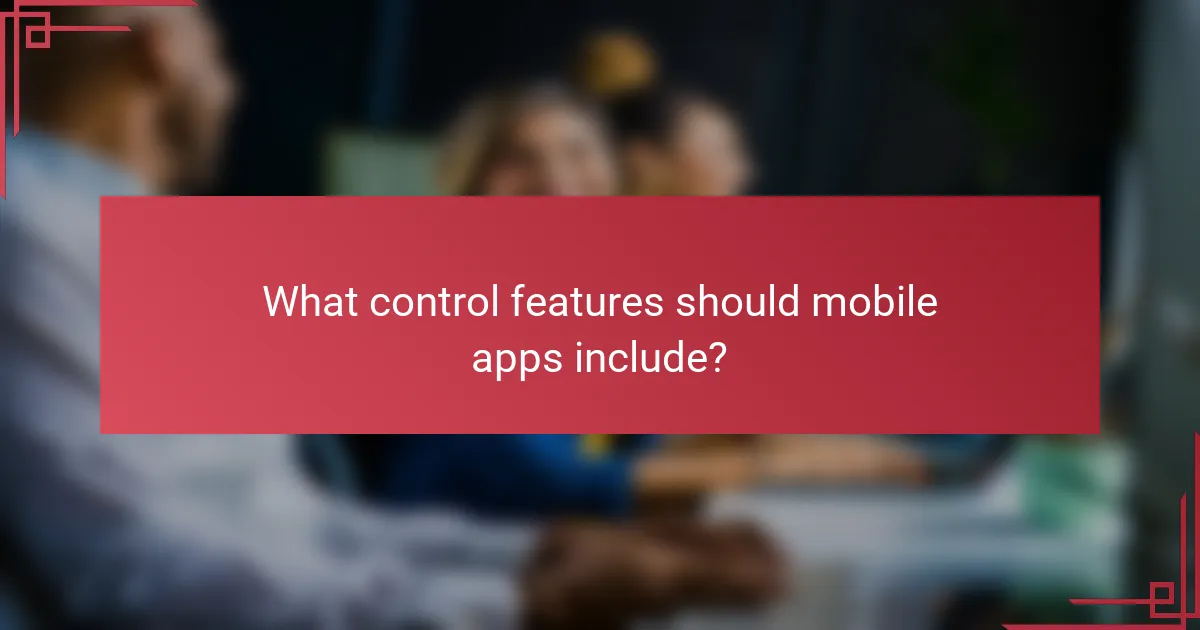In the competitive landscape of mobile applications, enhancing user experience is paramount, requiring intuitive interfaces and personalized content delivery. Effective integration practices ensure seamless connectivity and data management, while control features empower users to manage their privacy and preferences. By prioritizing these elements, developers can create engaging and trustworthy applications that meet user expectations.

How to enhance user experience in mobile apps?
Enhancing user experience in mobile apps involves creating an intuitive, engaging, and seamless interface that meets user needs. Key strategies include intuitive navigation, personalized content delivery, and responsive design principles.
Intuitive navigation design
Intuitive navigation design ensures users can easily find what they need without confusion. This can be achieved by using familiar icons, clear labels, and a logical flow of information.
Consider implementing a bottom navigation bar for primary actions, as it allows easy access with a thumb. Avoid cluttering the screen with too many options; instead, prioritize essential features to streamline user interactions.
Personalized content delivery
Personalized content delivery tailors the app experience to individual user preferences and behaviors. By analyzing user data, apps can present relevant content, recommendations, or notifications that resonate with each user.
Utilizing machine learning algorithms can enhance this personalization, allowing the app to adapt over time. However, ensure that users have control over their data and can opt-out of personalized features if they choose.
Responsive design principles
Responsive design principles focus on creating a flexible layout that adapts to various screen sizes and orientations. This ensures that users have a consistent experience across devices, whether they are using a smartphone or tablet.
Utilize fluid grids and scalable images to maintain usability on different screens. Test your app on multiple devices to identify any layout issues and ensure that touch targets are appropriately sized for easy interaction.

What are the best integration practices for mobile apps?
Effective integration practices for mobile apps focus on seamless connectivity, user experience, and data management. Prioritizing API strategies, third-party compatibility, and data synchronization ensures that apps function smoothly and meet user expectations.
API integration strategies
API integration is crucial for enabling communication between your mobile app and external services. Consider using RESTful APIs for their simplicity and wide adoption, which can enhance performance and reduce latency. Ensure that your APIs are well-documented and versioned to facilitate easier updates and maintenance.
When implementing APIs, prioritize security by using authentication methods such as OAuth. Regularly monitor API performance and error rates to quickly identify and resolve issues that may affect user experience.
Third-party service compatibility
Ensuring compatibility with third-party services is essential for enhancing app functionality. Evaluate potential services based on their reliability, support, and integration ease. Popular services include payment gateways, social media platforms, and analytics tools.
When integrating third-party services, check for SDKs that simplify the process and ensure they are regularly updated. Be cautious of over-reliance on external services, as this can lead to performance bottlenecks or increased vulnerability to outages.
Data synchronization techniques
Data synchronization ensures that user data remains consistent across devices and platforms. Implement strategies such as real-time syncing for critical data and periodic syncing for less critical information to balance performance and user experience.
Utilize local storage for offline access and background syncing to enhance usability. Be mindful of data privacy regulations, such as GDPR, when handling user data, ensuring that synchronization practices comply with legal requirements.

What control features should mobile apps include?
Mobile apps should include control features that empower users to manage their permissions, privacy, and interface preferences. These features enhance user experience by providing transparency and customization, which are essential for user trust and satisfaction.
User permissions management
User permissions management allows individuals to control what data and features the app can access. This includes permissions for location, camera, contacts, and notifications. Users should be able to easily grant or revoke these permissions at any time through the app settings.
It is crucial for apps to clearly explain why certain permissions are needed, as this transparency builds trust. A good practice is to request permissions only when necessary, rather than at the initial app launch, to avoid overwhelming users.
Data privacy settings
Data privacy settings enable users to manage how their personal information is collected, stored, and shared. Apps should provide options for users to opt-in or opt-out of data collection practices, as well as the ability to delete their data upon request.
Compliance with regulations such as the General Data Protection Regulation (GDPR) in Europe is essential. Apps should inform users about their rights regarding data privacy and ensure that privacy settings are easily accessible and understandable.
Customizable user interfaces
Customizable user interfaces allow users to tailor the app’s appearance and functionality to their preferences. This can include options for theme selection, font size adjustments, and layout changes. Providing these options can significantly enhance user satisfaction and accessibility.
Consider implementing a simple toggle feature for users to switch between light and dark modes, as well as adjustable text sizes. These small changes can make a big difference in usability, particularly for users with visual impairments.

How to choose the right mobile app development framework?
Choosing the right mobile app development framework involves assessing your project requirements, team expertise, and long-term goals. Key factors include performance, user experience, and the ability to integrate with existing systems.
Comparison of React Native and Flutter
React Native and Flutter are two popular frameworks for mobile app development, each with distinct advantages. React Native, developed by Facebook, allows for code sharing between iOS and Android, making it efficient for cross-platform development. Flutter, created by Google, uses a single codebase and offers a rich set of pre-designed widgets, resulting in a highly customizable user interface.
When considering performance, Flutter tends to have an edge due to its compiled nature, which can lead to faster execution. However, React Native benefits from a large community and extensive libraries, which can accelerate development time. Ultimately, the choice may depend on your team’s familiarity with JavaScript (for React Native) or Dart (for Flutter).
Native vs hybrid app development
Native app development involves creating applications specifically for one platform, such as iOS or Android, using platform-specific languages like Swift or Kotlin. This approach typically results in superior performance and user experience, as the app can fully leverage device capabilities.
On the other hand, hybrid app development combines elements of both native and web applications, allowing for cross-platform compatibility. While hybrid apps can be developed more quickly and at a lower cost, they may suffer from performance issues and a less polished user experience compared to native apps. Consider your budget, timeline, and performance needs when deciding between these two approaches.

What are the emerging trends in mobile app development?
Emerging trends in mobile app development focus on enhancing user experience through advanced technologies and integrations. Key trends include AI-driven personalization, augmented reality features, and the impact of 5G technology, all of which are reshaping how users interact with apps.
AI-driven user personalization
AI-driven user personalization tailors app experiences based on individual user behavior and preferences. By analyzing data such as usage patterns and interactions, apps can provide customized content, recommendations, and notifications that resonate with users.
For instance, streaming services often use AI algorithms to suggest shows or movies based on viewing history. This not only enhances user satisfaction but also increases engagement and retention rates.
To effectively implement AI personalization, developers should prioritize user data privacy and transparency, ensuring compliance with regulations like GDPR in Europe.
Augmented reality features
Augmented reality (AR) features integrate digital elements into the real world, enhancing user engagement and interaction. Apps in sectors like retail and gaming leverage AR to create immersive experiences, allowing users to visualize products in their environment before making a purchase.
For example, furniture apps enable users to see how a piece of furniture would look in their home through their smartphone camera. This not only aids decision-making but also reduces return rates.
When developing AR features, consider the hardware capabilities of target devices and ensure a seamless user experience to avoid frustration.
5G technology impact on mobile apps
The rollout of 5G technology significantly enhances mobile app performance by providing faster data speeds and lower latency. This advancement allows for more complex functionalities, such as high-definition video streaming and real-time multiplayer gaming, which were previously limited by slower networks.
With 5G, apps can handle larger data transfers and support more simultaneous users without lag, improving overall user satisfaction. For instance, mobile gaming apps can offer richer graphics and smoother gameplay experiences.
Developers should optimize their apps for 5G capabilities, ensuring they can leverage the increased bandwidth while maintaining compatibility with older network standards for broader accessibility.

How to measure mobile app performance?
Measuring mobile app performance involves evaluating various metrics that indicate how well an app functions and how users interact with it. Key performance indicators (KPIs) include load times, crash rates, and user engagement metrics.
Key performance indicators (KPIs)
Key performance indicators (KPIs) for mobile apps are essential metrics that help assess their effectiveness. Common KPIs include app load time, crash analytics, user retention rates, and session duration. Monitoring these metrics allows developers to identify performance bottlenecks and improve user experience.
Tools for measuring performance
There are several tools available to measure mobile app performance effectively. Popular options include Google Analytics for tracking user behavior, Firebase for crash reporting, and AppDynamics for real-time performance monitoring. Each tool offers unique features that cater to different aspects of app performance.
Best practices for optimization
To optimize mobile app performance, developers should focus on reducing load times and minimizing crashes. Techniques such as optimizing images, using efficient coding practices, and regularly updating the app can significantly enhance performance. Additionally, conducting regular performance tests can help identify areas for improvement.
Common pitfalls to avoid
When measuring mobile app performance, avoid common pitfalls such as relying solely on one metric or failing to consider the user experience. It’s essential to take a holistic approach by analyzing multiple KPIs and gathering user feedback. Ignoring the impact of network conditions on performance can also lead to misleading conclusions.



